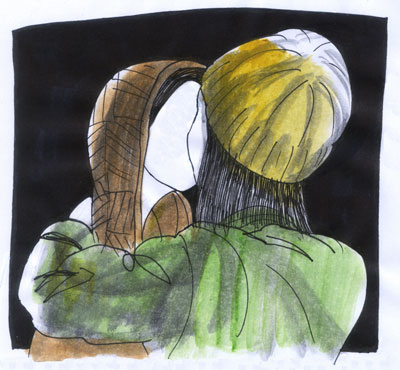 Every Saturday, we’ll be posting a new illustration by David Lester. The Mecca Normal guitarist is visually documenting people, places and events from his band’s 28-year run, with text by vocalist Jean Smith.
Every Saturday, we’ll be posting a new illustration by David Lester. The Mecca Normal guitarist is visually documenting people, places and events from his band’s 28-year run, with text by vocalist Jean Smith.
The museum’s board of directors—a semi-imaginary museum, a conceptual retreat—convened at the Japanese restaurant to deal with the details of the opening exhibit to take place on one wall of the studio. That’s where they were at. The ad for a publicist went up on Craigslist, and while none of them had formulated an image of who exactly might reply, it became obvious that they’d all assumed they’d be hiring a beautiful girl around their age dressed head-to-toe in black. The obviousness surfaced after an intense looking woman old enough to be their mother came into the Railway Street studio. The door squeaked closed behind her, and the four of them stopped painting to go and deal with the unexpected problem. They were polite, but they certainly didn’t invite her in to see the space or show her their work. Jeff quickly explained the drawbacks of the short-term position and without making eye contact, Mark hastily told her that they had several other people to see and they’d get back to her if need be. Nadine handed Jeff her resume and then, feeling very old, but mostly angry, she was back on Railway Street within four minutes of having pulled open the heavy door. She knew exactly what had happened. What irked her most was that they assumed she didn’t.
The painters returned to their easels and waited for more replies to their ad, but none came. Adam had in fact done a bit of research online and deduced that they were not eligible to apply for funding from the Canada Council for the Arts, but the toll-free number and the rather lovely female name next to it emboldened him to phone Françoise Lacroix and ask if she had any ideas of where funding to open a small museum might come from. They were Canadian taxpayers after all–or at least at some point in their lives they might be.
Françoise asked Adam what kind of a museum it was and Adam realized they needed to be specific so he said they were opening a museum of political art.
“The Black Dot Museum of Political Art,” Adam said, thinking about the imaginary dots on the table at Aikoko. Françoise was intrigued enough to give him the number of a colleague at the Institute of Museums and Libraries in Washington, D.C., that connected Adam to Steve, a former skate punk from the all-ages club Françoise hung-out at as a student at Carleton University in Ottawa. Steve liked Adam’s story, the real story, not a fake story to secure funding; he liked the idea of a small museum set up by four guys who didn’t want to sell out. Three days later at the Japanese restaurant, Adam announced that he’d sent Steve a rough draft of a budget to operate a museum of political art for three years. Rent, general expenses and one full-time employee.
Bruce dumped real paper dots out of a manila envelope, and they all laughed at the absurdity of the situation. What if they actually got funding? What if they actually had to open a real museum?
With the dots—art movements through the ages—scattered across the table and no other responses to the ad on Craigslist, Adam unfolded Nadine’s resume and passed it around the table.






